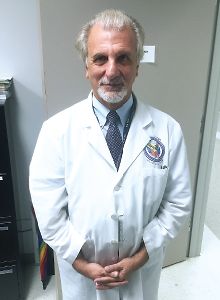Sertraline May Help Prevent Depression Following Traumatic Brain Injury
Abstract
Sertraline used prophylactically may be preferable to waiting to treat depression after TBI, researchers suggest.
Depression is common in people who have suffered a traumatic brain injury (TBI). For example, a 2010 analysis of TBI patients found that 53 percent met the criteria for major depressive disorder in the first year after injury. A study in 2002 found that over 25 percent of people with a history of TBI had depression 30 years later.
Treating TBI-related depression promptly and effectively is critical as it can compromise a patient’s ability to make a full recovery from the injury and increase the risk of long-term refractory depression. But questions remain about the effectiveness of antidepressants in this patient population and possible side effects from the medication.

While his recent findings provide more evidence that sertraline can help prevent depression after TBI, Ricardo Jorge, M.D., believes more work into the biology of this prophylactic effect is needed.
“Given the high prevalence of this disorder after a brain injury and the questionable efficacy of interventions, it might therefore be better to prevent, rather than treat, TBI-associated depression,” said Ricardo Jorge, M.D., a professor of psychiatry and behavioral sciences at Baylor College of Medicine.
Jorge and colleagues recently published a study in JAMA Psychiatry that compared the rates of depression in adults who took a low dose of the selective serotonin reuptake inhibitor (SSRI) sertraline over six months following a recovery from a TBI with those who took placebo. After 24 weeks, only 6 percent of patients receiving sertraline developed depression, compared with 22 percent in the placebo group. This rate calculated out to a number needed to treat of 5.9 for sertraline—that is, for every six TBI patients given sertraline prophylactically, the findings suggest one case of depression was prevented.
Compared with the 150 to 200 mg/day dose of sertraline commonly prescribed for depression management, the sertraline dose in the JAMA Psychiatry study was capped at 100 mg/day— a dose Jorge noted appeared to be well-tolerated in the TBI patients.
This is not the first study to explore sertraline as a preventative agent. In 2009, a team at the University of Alabama-Birmingham led by Jay Meythaler, M.D., identified a similar protective potential in a clinical study of 99 adults with TBI.
That study, which involved giving patients 50 mg/day of sertraline, also found fewer incidences of depression after three months; none of the participants in the sertraline group had a Hamilton Depression Rating Scale score of 6 or greater, compared with 10 percent in the placebo group. These findings were published in the Journal of Neurotrauma.
Jesse Fann, M.D., M.P.H., a professor of psychiatry and behavioral sciences and adjunct professor of rehabilitation medicine at the University of Washington School of Medicine and co-author of the 2010 assessment of major depressive disorder in patients who experienced a TBI, said he is encouraged by these findings. Still, he told Psychiatric News, more research is needed to determine the optimal duration of prophylactic antidepressant treatment and whether prophylactic antidepressants are cost effective.
Meythaler concurred, noting how in his study, once the TBI patients were taken off medication at the study’s conclusion, more depression was reported in the group; by the one year follow-up, the rates of depression in patients who had taken three months of sertraline were the same as the placebo group.
Meythaler noted there are other reasons clinicians might consider prescribing SSRIs to patients with TBI. For instance, SSRIs are commonly prescribed to manage pseudobulbar affect—uncontrolled, inappropriate laughing and/or crying that is common during the early stages of recovery from neurological damage. Some studies have also found that SSRIs can improve cognitive and motor recovery in stroke patients, and that has translated to broader use in brain rehabilitation.
Meythaler noted that both his TBI study and that of Jorge explored cognitive recovery rates in response to sertraline, but unlike the previous work in stroke patients, they found no evidence that sertraline improved attention, working memory, or other neuropsychological measures when compared with placebo.
Jorge believes that future studies should try to identify the mechanism by which sertraline confers protection. “We need to know about the biology of this phenomenon; what is going on in the brain?” he said. Answering this question may help identify optimal treatment protocols, which then can be used to plan large, multisite clinical studies, he added.
Jorge’s study was funded by a grant from the National Institute of Neurological Disorders and Stroke. Meythaler’s study was funded by a grant from the National Institute on Disability, Independent Living, and Rehabilitation Research. ■
An abstract of Jorge’s study, “Sertraline for Preventing Mood Disorders Following Traumatic Brain Injury: A Randomized Clinical Trial,” can be accessed here. An abstract of Mey-thaler’s study, “Impact of Early Administration of Sertraline on Depressive Symptoms in the First Year After Traumatic Brain Injury,” is available here.



